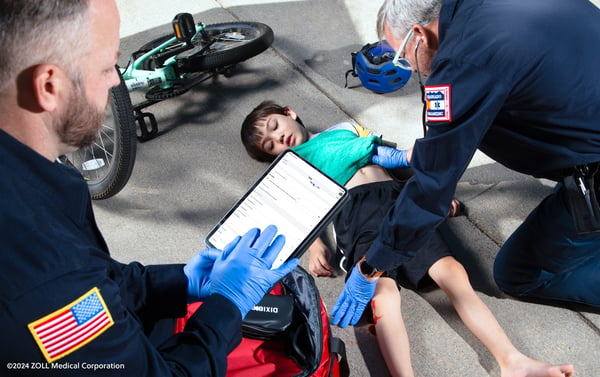Chart Smarter: Why One EMS Agency Ditched Paper for Mobile Tech
Tips for EMS Agencies to Resolve Today's Patient-Pay Accounts
Everywhere I go, ambulance providers, billing companies, and billers ask, “Why do patients think that ambulance service is free?” Across our industry, we hear from patients who incorrectly believe that ambulance service is fully tax-supported or that insurance covers all costs
Was this information valuable?

Everywhere I go, ambulance providers, billing companies, and billers ask, “Why do patients think that ambulance service is free?” Across our industry, we hear from patients who incorrectly believe that ambulance service is fully tax-supported or that insurance covers all costs. Their implied pushback on the cost of EMS transport may only increase as we face a rising uninsured population expected to reach 31.5 million by the end of 2020i from the impact of the pandemic.

We must be prepared to respond to growth in self-pay accounts. Services are already stretched thin with the increased costs related to COVID-19. Now is the time to get in front of these cash flow problems. Importantly, whether billing is outsourced or done in-house, I recommend that organizations take the following actions now, especially the last step - #6.
Review and update your internal collection approach with these proven methods:
-
- Tell patients about their financial responsibility. Whether emergency or non-emergency service was provided, patients will look at your website. Post information about fees for service, financial responsibility for co-payments and deductibles, payment options, time-payment plans, and financial hardship. Note that Medicare beneficiaries have a 20% co-payment for service. If the patient has supplemental insurance, tell them how to communicate that information. Note any special issues related to auto or workers compensation insurance. For example, auto may pay 80%, while health pays 20% in your state. It is important to include any state regulations about balance billing. If you need help with what the state requires, contact your local state legislator for assistance.
I see EMS agency websites that offer a method to pay the bill, but which do not outline expectations about the bill. Expand the information provided to your patients about insurance billing. Tell them that you can help with navigating insurance, but that they have financial responsibilities beyond the insurance coverage. - Update write-off, financial hardship, and time-payment plan policies. Since the policies will appear on your agency website, it is a good time to review the approach to write-off, financial hardship, and time-payment plans. If billing is outsourced, the vendor needs to be involved in this discussion. They are knowledgeable and experienced. They can assist your efforts. Regardless, there are basic rules that must be followed.
Remember, Medicare has a “reasonable collection effort” requirement that providers collect co-payments and deductibles. See the Medicare Provider Reimbursement Manual, Part 1, Chapter 3, Transmittal 435. Basically, Medicare requires that all billing be consistent. Providers may use a collection agency, but they do not have to do so. If the patient has financial hardship, that issue needs to be considered. A financial hardship policy does not have to be overly complicated. Use the Federal Poverty Guidelines which outline the number of people in the household and their annual income. These guidelines are updated annually, usually in January or early February. If the patient falls within those guidelines, the balance of the claim may qualify for write-off. As an extra measure, prepare a one-page document that the patient signs to agree that if their financial circumstances change, they will pay the bill. This step can help reassure anyone concerned that the patient may come into money in the future. - Educate non-emergency call takers and coordinate with billing. If wheelchair services and non-emergency ambulance are offered, ensure that call takers and billers communicate about fees and billing options. Conduct a monthly — or at least quarterly — meeting with these two groups. There are opportunities to collect at time of service or to arrange payment for non-emergencies. If billing is outsourced, a billing company representative and your call intake managers should schedule routine meetings to solve problems and keep abreast of policy updates.

- Maintain credit card information on file. Obtain permission to maintain the patient’s credit card on file. This can be helpful for routine users of service, such as people who reside in a facility or use repetitive services. Cost-share amounts go to the credit card on file. Set a cap on what amount will go to the card (e.g., agree that no more than $100 will be charged to the card unless patient is alerted). It is important to check with local counsel to stay compliant with state and local law. Local counsel can advise on language needed and forms management.
- Consider new technologies. Contactless payments became the rage during the pandemic. So, too, did opportunities to pay for service by text. As a result of the pandemic, vendors who offer these services have worked to expand their technology. Investigate texting options which can alert patients routinely and collect payments by text – including time payments! This approach saves staff time from calling patients. Catching patients on the phone is unreliable. Consider employing technology instead.
- Test your own billing and payment system. This is the most important step. Try to pay your own bill. Have a “dummy” self-pay invoice prepared for a small amount. At some time after normal business hours, try to pay the bill through your own payment system. See how smooth the process works (or does not work). If billing is outsourced, have the vendor prepare a “dummy” self-pay invoice and try to pay it. I have seen many examples of billing services who were unaware of problems with their self-pay system because no one in the organization had used it. The system needs to run smoothly at all hours of the day and night. Patients do not pay bills exclusively between 9 am and 5 pm. Ensure that the process works smoothly.
- Tell patients about their financial responsibility. Whether emergency or non-emergency service was provided, patients will look at your website. Post information about fees for service, financial responsibility for co-payments and deductibles, payment options, time-payment plans, and financial hardship. Note that Medicare beneficiaries have a 20% co-payment for service. If the patient has supplemental insurance, tell them how to communicate that information. Note any special issues related to auto or workers compensation insurance. For example, auto may pay 80%, while health pays 20% in your state. It is important to include any state regulations about balance billing. If you need help with what the state requires, contact your local state legislator for assistance.
There is no one-stop cure for self-pay problems. However, consistency, good policies, and communication with patients will make a difference. The pandemic has prompted much introspection regarding our approach to service. Let us apply the same diligence to self-pay management.
Related Posts
The End of Delayed Documentation
4 Must-have Data Points for Dispatch-Billing Alignment and Maximum Reimbursement
ZOLL Pulse Blog
Subscribe to our blog and receive quality content that makes your job as an EMS & fire, hospital, or AR professional easier.
ZOLL Pulse Blog
Subscribe to our blog and receive quality content that makes your job as an EMS, fire, hospital, or AR professional easier.




